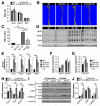Bone marrow adipose tissue is an endocrine organ that contributes to increased circulating adiponectin during caloric restriction
- PMID: 24998914
- PMCID: PMC4126847
- DOI: 10.1016/j.cmet.2014.06.003
Bone marrow adipose tissue is an endocrine organ that contributes to increased circulating adiponectin during caloric restriction
Abstract
The adipocyte-derived hormone adiponectin promotes metabolic and cardiovascular health. Circulating adiponectin increases in lean states such as caloric restriction (CR), but the reasons for this paradox remain unclear. Unlike white adipose tissue (WAT), bone marrow adipose tissue (MAT) increases during CR, and both MAT and serum adiponectin increase in many other clinical conditions. Thus, we investigated whether MAT contributes to circulating adiponectin. We find that adiponectin secretion is greater from MAT than WAT. Notably, specific inhibition of MAT formation in mice results in decreased circulating adiponectin during CR despite unaltered adiponectin expression in WAT. Inhibiting MAT formation also alters skeletal muscle adaptation to CR, suggesting that MAT exerts systemic effects. Finally, we reveal that both MAT and serum adiponectin increase during cancer therapy in humans. These observations identify MAT as an endocrine organ that contributes significantly to increased serum adiponectin during CR and perhaps in other adverse states.
Copyright © 2014 Elsevier Inc. All rights reserved.
Figures



References
-
- Behre CJ, Gummesson A, Jernas M, Lystig TC, Fagerberg B, Carlsson B, Carlsson LM. Dissociation between adipose tissue expression and serum levels of adiponectin during and after diet-induced weight loss in obese subjects with and without the metabolic syndrome. Metabolism. 2007;56:1022–1028. - PubMed
-
- Bennett CN, Ouyang H, Ma YL, Zeng Q, Gerin I, Sousa KM, Lane TF, Krishnan V, Hankenson KD, MacDougald OA. Wnt10b increases postnatal bone formation by enhancing osteoblast differentiation. J Bone Miner Res. 2007;22:1924–1932. - PubMed
-
- Combs TP, Berg AH, Rajala MW, Klebanov S, Iyengar P, Jimenez-Chillaron JC, Patti ME, Klein SL, Weinstein RS, Scherer PE. Sexual differentiation, pregnancy, calorie restriction, and aging affect the adipocyte-specific secretory protein adiponectin. Diabetes. 2003;52:268–276. - PubMed
Publication types
MeSH terms
Substances
Grants and funding
- K12 HD055887/HD/NICHD NIH HHS/United States
- R24 DK092759/DK/NIDDK NIH HHS/United States
- UL1 TR001114/TR/NCATS NIH HHS/United States
- K08 DK102357/DK/NIDDK NIH HHS/United States
- 1R03AR055333/AR/NIAMS NIH HHS/United States
- R01 DK090262/DK/NIDDK NIH HHS/United States
- T32 GM008322/GM/NIGMS NIH HHS/United States
- R01 DK062876/DK/NIDDK NIH HHS/United States
- R03 AR055333/AR/NIAMS NIH HHS/United States
- K99-DE-024178/DE/NIDCR NIH HHS/United States
- T32 DE007057/DE/NIDCR NIH HHS/United States
- K23 DK094820/DK/NIDDK NIH HHS/United States
- P30 DK089503/DK/NIDDK NIH HHS/United States
- T32 HD007505/HD/NICHD NIH HHS/United States
- N02 DK062876/DK/NIDDK NIH HHS/United States
- 1K12-HD055887/HD/NICHD NIH HHS/United States
- 8UL1TR0001114/TR/NCATS NIH HHS/United States
- R01 DK62876/DK/NIDDK NIH HHS/United States
- P30 DK020572/DK/NIDDK NIH HHS/United States
- T32 GM007315/GM/NIGMS NIH HHS/United States
- K99 DE024178/DE/NIDCR NIH HHS/United States
LinkOut - more resources
Full Text Sources
Other Literature Sources
Molecular Biology Databases
